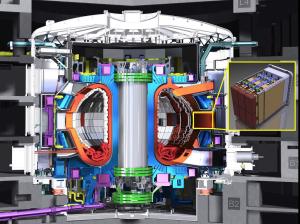Teamwork in action: ITER diagnostics and electromagnetic design
9 May 2016
-
ITER-PPPL team for diagnostic port plugs
ITER diagnostics will be integrated into massive components called port plugs. Work is underway now on the structural design of the port plugs, which must take into consideration eventual electromagnetic loads.
ITER diagnostic systems will be vital in controlling the plasma as well as evaluating and optimizing machine performance. Required to "see" the plasma from many different angles, diagnostics will be installed in different locations around the vacuum vessel, integrated in port structures called "port plugs."
Port plugs are massive components—up to 50 metric tons each—that seal the vacuum vessel port openings during operation and that will provide shielded housing, as well as a front-row seat, for instruments. At least 22 of ITER's 33 port plugs will be customized to house diagnostics.
Since 2010, work has been underway on the engineering and port integration of ITER diagnostics based on a "generic" design that, for the moment, excludes the specificities of individual diagnostics to concentrate on methodology and technology. Carried out in collaboration with a team from the Princeton Plasma Physics Laboratory (PPPL), the work has focused on the generic design of equatorial and upper diagnostic port plugs, taking into consideration the design of the port cell infrastructure, interspaces and support structures as well as auxiliary components like windows and services such as cables and feedthroughs.
Julio Guirao, from the ITER Common Port Plug Engineering team, and Yuhu Zhai, from the Princeton Plasma Physics Laboratory (PPPL), are working together to coordinate the effort toward a common component design that meets the challenging requirements for ITER diagnostics. They are pictured here at PPPL in front of coils from NCTX (the stellarator experiment that was cancelled in 2008).
The major driver for the structural design of the generic equatorial and upper port plugs has been the need for the port plugs to withstand disruption forces and plasma vertical displacement events (a sudden vertical displacement of the plasma that can lead to extremely heavy loads). Although of extremely short duration—on the order of a few tens of milliseconds—they would induce large electromagnetic loads on the structural components of the port plugs.
Consider the case of a Formula 1 race car. During normal operation the forces are fairly low, but inertial loads become a big factor when the car stops abruptly—in hitting a car or a barrier, for example. By design, it needs to resist the different types of forces it will encounter on the circuit, and to protect its payload and maintain its integrity. In ITER, the equivalent of an abrupt stop comes from rapid changes in the magnetic fields.
To study and predict these electromagnetic loads, and inertial effects, a joint ITER-PPPL team has come together to develop efficient and cost-effective electromagnetic (EM) analysis models able to handle interfacing actions. The team has also developed a critical electromagnetic data mapping procedure to integrate electromagnetic analysis with the structural analysis that defined load specifications for the generic plug and first-wall designs. This will ensure the structural integrity, and sound dynamic behaviour, of the diagnostic infrastructure for integration into the port.
To study and predict these electromagnetic loads, and inertial effects, a joint ITER-PPPL team has come together to develop efficient and cost-effective electromagnetic (EM) analysis models able to handle interfacing actions. The team has also developed a critical electromagnetic data mapping procedure to integrate electromagnetic analysis with the structural analysis that defined load specifications for the generic plug and first-wall designs. This will ensure the structural integrity, and sound dynamic behaviour, of the diagnostic infrastructure for integration into the port.
This is no simple task as the conventional approach to performing independent neutronic, electromagnetic, thermal-hydraulic and structural dynamic analysis alone isn't able to meet the full challenge of ITER diagnostics' engineering design and port integration. Highly innovative, multi-scale simulation solutions are required to take into account the full complexity of the engineering design, including the diagnostic apertures at the plasma-end of the port plugs.
Members of the joint ITER-PPPL team for diagnostic port plugs: Wenping Wang, Andrei Khodak, Julio Guirao, Yuhu Zhai, Jingping Chen (front); Irving Zatz, Doug Loesser (back).
A multi-physics engineering analysis protocol—with CAD design models integrated into state-of-the-art analysis tools—has been developed and implemented as a baseline methodology established for the port plug structure and first wall design. As a result, the ITER design can be cost effective, consistent and soundly justified through analysis.
So how has all this gone lately? The generic equatorial and upper port plug structures and diagnostic first walls successfully passed a number of design review phases between 2011 and 2014. Design workshops were held last year for the diagnostic shielding module and, in January, an electromagnetic analysis workshop was successfully held for the diagnostic port plugs and in-port diagnostics.
Julio Guirao, from the ITER Common Port Plug Engineering team, and Yuhu Zhai, from the Princeton Plasma Physics Laboratory (PPPL), work in close association to coordinate the effort toward a common component design that meets the challenging requirements for ITER diagnostics. "The EM workshop helped us to have a better understanding of the design driving electromagnetic disruption loads. We can now move forward in full speed for component design and port integration."
Collaboration will continue between the ITER Organization Common Port Plug Engineering team and PPPL on the design of the diagnostic first wall and the diagnostic shielding module.




